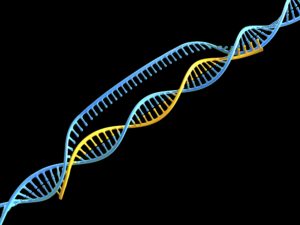The therapeutic potential of chemically synthesised oligonucleotides

Nucleic acids (RNA and DNA) have a plethora of functions in biological systems, many of which are only recently being uncovered. The ubiquity of this unique class of biomolecules makes them an ideal candidate for use as cutting-edge pharmaceuticals as well as for applications in forensic testing and gene editing. Efficient methods to synthesise robust, bespoke and non-natural nucleic acids with new functionality are therefore highly sought after.
Researchers at the University of Oxford have developed a chemical synthesis strategy for producing DNA incorporating non-natural backbone structures and locked nucleic acid (LNA) sugars which convey desirable properties such as more selective and robust binding to complementary nucleic acids and greater resistance to enzymatic degradation. These systems have the potential for use as therapeutic agents.
Nucleic acids – Encoding life
DNA and RNA are biomolecules that are fundamental to all known forms of life. In recent years, many successful attempts have been made to harness the myriad functions of nucleic acids and apply them in the fields of human medicine, forensics and genetic testing. In general, these applications use DNA and or RNA produced through well-established solid phase synthesis methods. These mostly contain chemical modifications that have been established for very many years. Emerging applications, particularly in therapeutics, require more robust nucleic acid structures, with customisable properties to improve in vivo stability and delivery, so new designs and synthetic approaches are required.
New nucleic acid analogues – Improving on nature
To meet the demand for increased efficacy created by breakthroughs such as the recent development of several clinically approved therapeutic oligonucleotides, researchers have sought novel nucleic acid analogues. One such approach utilises azide-alkyne “Click” chemistry to generate a triazole surrogate of the natural phosphodiester backbone. However, the presence of such groups in the DNA/RNA backbone renders the resulting biomolecules unable to efficiently bind (by Watson-Crick base pairing) to complementary DNA/RNA sequences. The selectivity and strength of this binding are crucial to its application.
LNA – Locking in new features
Researchers at the University of Oxford have exploited the triazole linkage in combination with locked nucleic acids (LNAs) to yield oligonucleotides which display higher target binding affinities and greater resistance to enzymatic degradation. In addition, reagents have been developed which allow for easy incorporation of this functionality by standard automated solid phase synthesis methods.
The main benefits of the Oxford Triazole-LNA approach are:
- A significant increase in DNA:RNA duplex stability (target affinity) compared to triazole alone
- Less susceptibility to enzymatic degradation than native DNA/RNA
- Synthesis by rapid, efficient and scalable solid phase techniques
- Ability to modulate or eliminate anionic charge on DNA/RNA analogue
Protection and Applications
This technology is the subject of two patent applications and Oxford University Innovation is keen to talk to anyone who is interested in their commercialisation.
about this technology

